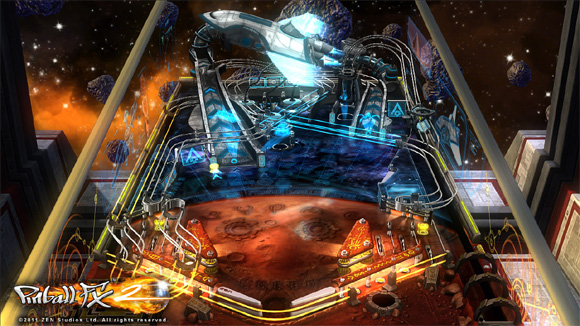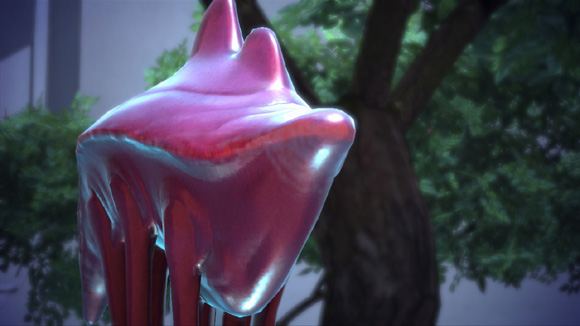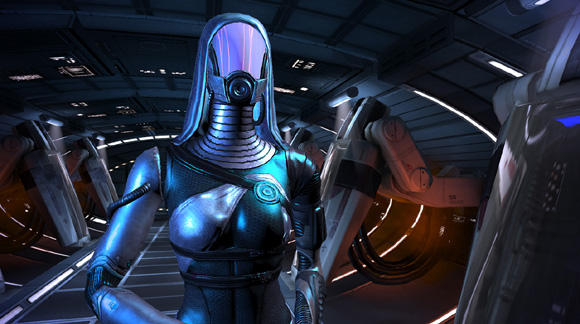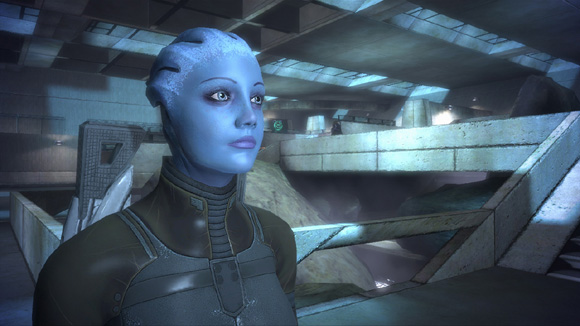Thor: God of Thunder

Movie to Game Tie-ins have been a tradition since video gaming hit the mainstream. They have a reputation of being hashed together quickly, follow the same story as the film and are generally sub-par. SEGA have decided with THOR: God Of Thunder to change tact slightly.
Written by the Thor (comic) writer Matt Fraction who also lent his talent to the story of Iron Man 2 The Videogame, is more of an alternative take on the comic book series. This also features the voices talents of Chris Hemsworth and Tom Hiddleston who play Thor and Loki in the film, which is a welcome change. The game has a short introduction to the surrounds of Asgard and then plunges hammer-first into the first battle against the evil Frost Giants of Jotunheim.
While the exciting opening throws Thor straight into the heart of battle, frustratingly the game insists on teaching all of the “basic” combination attacks and magic spells, which involve pressing the X button a set number of times then finishing the combo with Y. This detracts from the excitement and puts a dampener on the battle.
Progressing through the first level, the God of Thunder is quickly trained on aspects of the combat system, such as grappling foes, flying, the rage meter and most importantly – Valor points. Grappling enemies and flying are used as action points and can only be used in certain circumstances. For instance when a large area needs to be covered or when a Frost Giant has it’s armour broken.
The Rage meter is again only used in certain points, primarily when there are an exceptional number of bad guys and a sub-boss is following straight after. The meter is built up by killing enemies and once unleashed causes an electrical storm to attack the remaining squadron.
Valor however is a different kettle of fish. Valor points act like experience points in a RPG. They are earned by seeing off the bigger enemies. These can be spent on upgrading Thor’s powers, be it increasing HP or by upgrading the spell set. This system is basic and is very easily completed. It lacks any challenge to complete all of the upgrades.
As the game progresses, it quickly becomes that God of Thunder it is just one button bashing battle after another with a minimal plot to follow. Each level is played out like the last, with different background scenery to keep interest. Granted that there is some movement, but that is only to link the fights. Playing through this does become tedious as it is very repetitive in nature. Also while in combat if the camera is disturbed in anyway it tends to auto centre to the screen as opposed to Thor himself. This means Thor can spend sometime looking back through the TV screen rather than facing the enemy trying to kill him.
The boss battles are a refreshing change of pace. Button bashing the controller won’t see off the big bad guys. This time well timed attacks and looking out for that all important grapple icon will win the day. However because of the temperamental fighting system/camera angle there will be a few uncalled for deaths.
Graphically the game is a mediocre looking by today’s standards. It looks like it was ported directly from the Wii with blurry textures and the occassional invisible wall that appears every so often. SEGA didn’t seem to make use of the High Definition functionality that the Xbox 360 produces. The game music and sound effects are ample however apart from the two main characters being who they are, nothing that truly stands out.
This is a shame as SEGA had the right ingredients to break the curse of the movie tie-in, a Marvel writer, voices from the actors in the film and a story that wasn’t ripped straight from the movie. There are little gems to be found in the game such as 3D capabilities when played through a 3D TV and random facts from the Thor comics on the loading screens. The game feels like it was rushed in quite a lazy way.
The game is good up until the realisation sets in that button bashing is what is going to happen until the very end. Unfortunately this happens very early on around level 3. Thor: God of Thunder isn’t a terrible game but with it becoming repetitive quickly and with the camera issues, substandard graphics and lack of story means it is forgettable. The game will rest in the realms of limbo rather than being sitting in the chamber of kings which it easily could have been!
Pinball FX2 Mars


The introduction of Pinball FX2 on the Xbox Live Arcade shows their continued commitment to the ways of the pinball. It’s clear from the moment the game has been installed that it’s going to be what was imagined on pinball tables of the late 80s, fast, furious fun with techno elements and a cyberpunk behaviour. Well, maybe not cyberpunk but the elements of weird space age technology and an attempt at a storyline are there.
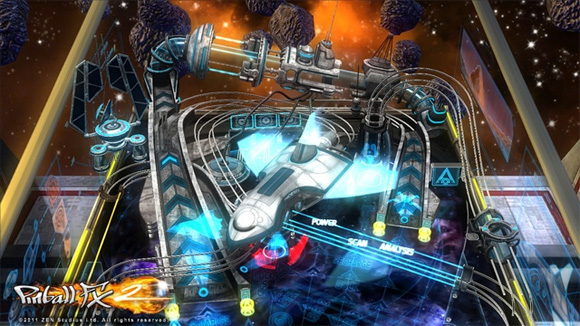
Each table is an entirely separate level and there’s little attempt to link together the varying storylines of the table; however, the storyline is not the main element of the game. It’s all about the pinball. There are various tables; but we are reviewing the Mars Table. The story is that humans set foot on Mars in 2100 and we are trying to colonise the planet; however, it requires a large amount of exploration and an attempt to scan the planet and make everything OK for future humans.
The storyline is simplistic and only adds different features to the board, such as satellite scanning and requiring certain missions to be completed. Of course, there is a limited amount of missions that can be completed with a pinball – this isn’t Sonic Pinball where control of the character is available, much the opposite. The table behaves like a true pinball table, the plunger on the right to shoot the ball into action and the flippers at the bottom centre to allow the player to fling away the pinball should it be close to harm. There’s a flipper half way up the level as well, so that provides extra ability to gather as many points as possible.
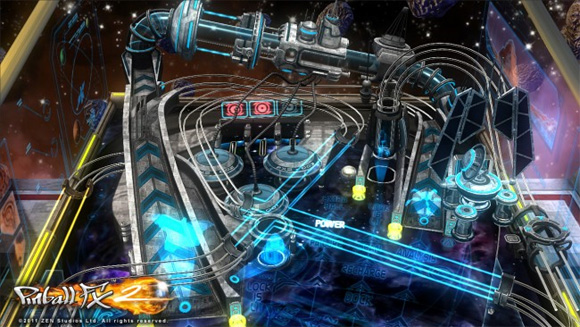
The design and physics of the game is next to perfect, with the pinball flying all over the screen and when it reaches the flappers slows down accordingly. It really does feel and behave like a pinball machine, by waggling on the analogue stick there’s even the option of making the table move a bit. Of course, do it too much and the controls freeze and the pinball will just fall to its doom.
The design of the Mars Table is a classic pinball machine table, with lots of chrome, bumpers, racks and everything else imaginable. It even has the over shinyness that’s only really seen on chrome metal. Towards the top of the table, it is very easy to loose the pinball, as there’s a lot of design covering where the pinball actually is and it often ends up on the higher level. Luckily, the pinball glows when it’s on the track, but it’s still easy to loose track of where everything is. Additionally where the score is tracked, the menu also turns into a place for messages to be sent to the player; yet, when part way through a mission the score disappears for extended periods at a time and this can leave the player frustrated.
With two different modes, Multiplayer and Single Player and a Leaderboard there’s plenty to keep a gamer entertained, especially as the Leaderboard is automatic and it’s clear to see what the target is to be #1 on that table is. The result is hours spent on the pinball table trying to rack up tens of millions of points. There are also a number of Achievements to be awarded; however, the majority of them aren’t for the Mars Table.
The actual title, Pinball FX2 is available as a free download on the Marketplace; however, once the game has installed you then have to purchase the tables. Therefore, it is a little deceiving, as it’s not actually a free game at all. Yet, if you are a pinball fan, it’s a very solid pinball title with some great tables.
Pinball FX2 Mars Table is a solid pinball game that will have fans of the genre absorbed for many hours. With various other tables available and a good online mode, the game is a must for pinball and casual game fans alike.
Mass Effect


Playing as Commander Shepard you are en route to the human colony: Eden Prime, where a new piece of ancient technology has been uncovered. The mission is top secret and it would appear that even the majority of the crew are unaware of this. Within a fairly short space of time, the crew are on the human colony and it becomes clear that the secret is out and the colony has been destroyed. It’s at this point we discover the true cause of the problem. So as the Commander you take these problems to the Human Council, but we’re not the dominant race in the Universe. Far from it. There’s a form of space government and a centralised hub for all politics in space called the Citidel and that’s where after a few action packed minutes, the player ends up – for ages.
Mass Effect likes to talk, talk and talk a little more. Rather than letting the player learn a little at a time between space missions, it throws you straight into the middle of some political game. After the first few action packed minutes, or an hour or so to be fair, the game suddenly becomes a case of running around a giant space ship learning about the intracicies of the political life in space. Not to mention hundreds of different species, who all seem to hate humans, gibbering away and generally being somewhat tedious. It’s at this point many gamers could easily just switch the Xbox off and forget about Mass Effect.
However, this would be a big mistake. After the first round of intergalactic politics, Commander Shepard earns the right to be a little freer with what he wants to do. With this newly found power, he’s also backed by the human council and starts to fly off all over known space to try and capture the perpetrator to the mass human murder on Eden Prime. Whilst trying to take down this evil person, you find out his true intentions, a plot that would do far more damage than just destroy the humans.
Yet, with all of the new found information, the game still wants to talk to you. It would be unfair to say that the majority of the information provided is dull, or even, unnecessary but there are methods of delivery and in many cases the delivery is failing. The actual system developed to talk to the non-playable-characters is very good, it’s essentially a question and answer game where you get varied responses depending on what sort of question is asked. The order of the questions can also be vital. It’s also challenging to get the same sequence of answers twice, if the unfortunate happens and Commander Shepard sees an early grave, replaying the level will normally lead to a different result. Then again, there’s talking and fact finding and whilst the technical elements of Mass Effect’s system works, it would just appear that there’s too much story at any one time.
There’s also a fair amount of action to be had whilst playing the game, well, after the Citadel has been left. The first thing to note is that weapons tend not to have any ammo and are usually unlimited; however, nothing is perfect in the Galaxy and whilst there may be no ammo weapons can overheat. In the early stages of the game it can take up to 10 seconds for the weapon to cool enough to start firing again and 10 seconds is all it takes between life, death, or a tactical retreat. This may at first seem like a bit of a cop-out, after all, this is meant to be a RPG game with First Person Shooter elements, where’s the tactics or challenge in an unlimited ammo gun. The tactics come from the fact that in most cases, there are multiple enemies and a limited number of shots before the weapon shorts-out.
Luckily the game can either be micromanaged to the point where even OCD sufferers can be happy, or left to grow organically. Using the D-Pad you can control the squad and tell them to shoot, go to certain places or just ignore that all together and let them kill on their own terms. Either way works and whilst it does take a little getting used to, the D-Pad works very well.
There’s an obscene amount of customisation at almost every level in the game. Commander Shepard can be a man, woman, handsome, ugly, strong, strong, clever, quick, pretty much any combination you can possibly imagine and Mass Effect will let you do this. Tagged alongside the extensive menu screens and the complex way of talking to people and this game will never be the same twice.
Final Verdict:
8/10
Mass Effect is a game that knows where it’s going and knows what it wants to say – and you’re going to listen. Even if you don’t want to. With an insane amount of customisation available, extensive levels and attention to detail abound it’s a great title to gently ease a gamer into action style games, or even back into the RPG world.
Toy Story 3: The Videogame

Movie to videogame adaptations are simply one of the worst things to happen to videogames, since Hollywood thought it would be a great idea to make movies from videogames. It seems that whenever these two entertainment juggernauts come together, or in a more real world term think that they can con some poor parent out of cash, as their kids loved the film, nothing good can or has ever come of it. There is dozens of failed movie to videogame adaptations on the market from the past few years, Hulk, Iron Man, The Golden Compass, Cars and arguably some of the Harry Potter games. Therefore, the expectation for Toy Story 3: The Videogame is low, very, very low, which happens to be the polar opposite to that of the film.
More often that not, it’s easy to jump straight into playing the actual game itself and ignore the other details. After all, these menu screens and everything else are simply a distraction from what actually needs to be done – game playing. However, with Toy Story 3: The Videogame on the Xbox 360, the title screen to the game will immediately pull the player away from the real world and teleport them back about a decade with the familiar music of “You’ve Got a Friend in me”, and make us all weep about our long-gone childhood. This instantly recognisable music makes the player feel much more at home and although this is a deceiving tactic, it works well for this game.
The menu screens are a breeze and it doesn’t take long before the player is able to select the type of play they want. There are two main modes of play, Story Mode, which takes the player through 8 levels. Each is expansive and is themed around the Toy Story 3 movie; however, it does not follow the same storyline as the film. The majority of these worlds are in a third person format and require the player to run around the world and collect different items, hit certain types of switches and just generally achieve what the story’s goals are set out to be. It’s standard gaming fare, with third party play interjected with the odd “on-the- rails” shooter action. This occasional switch is welcome as it changes the pace of Toy Story 3: The Videogame and although the gameplay isn’t dull, it is always good to see a different element introduced in games. The Story Mode is well thought out, with overarching plots that move between the worlds; however, sometimes they do feel a little stretched and some of the sidequests along the way are a bit stale and linear. Yet for the most part the Story Mode is well considered and actually a little challenging; it is not a walk through the park for a seasoned gamer.
The other mode available in Toy Story 3: The Videogame is ToyBox Mode, which is in its most basic form is a free roaming game. The player is Woody, who is in control of his own little western style town and he has the ability to go wherever he wants and do whatever he likes. There are missions assigned to the player by random characters in the game and you can either fulfil or ignore them. The ability to build in the town is available and the entire game is entirely customisable. It’s a very unique experience from a movie to videogame and it’s a welcome one.
Not to say that it is perfect, there are a few niggles with the display of the world and more importantly the controls are fairly, especially for a child’s game. The movement around the worlds isn’t flawless either, there’s a bit of lag or the controls simply aren’t as finely tuned as one would like. Yet, these niggles can be put aside due to the sheer beauty of the game. It’s been polished incredibly well and the developers at Avalanche Software and Disney Interactive Studios have really put their all into the presentation of Toy Story 3: The Videogame. With well-designed characters, that are bright and distinct against a variety of equally well made levels. Not only that but they move fluidly, there’s no jerky Tomb Raider on the PlayStation style movement, it’s smooth and a pleasure to view. It could easily be mistaken for the film in 2D. They have also managed to secure the majority of the original cast for the films for the voice acting work on the game, which makes a whole world of difference.
Verdict:
6/10
Toy Story 3: The Videogame is one of the best movie to videogame adaptations ever. With a well thought out plot, a gameplay that is well developed and a style that mirrors the movie without copying it. It is certainly not perfect, but it’s the closest a movie to videogame adaptation has been in a long, long time.







